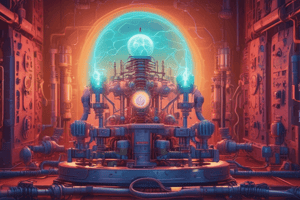Podcast
Questions and Answers
What are the Four Laws of Electrostatics? (Select all that apply)
What are the Four Laws of Electrostatics? (Select all that apply)
- Unlike charges attract; like charges repel (correct)
- Electrostatic force is inversely proportional to the product of the electrostatic charges
- Electric charge of a conductor is concentrated along the sharpest curvature of the surface (correct)
- Electric charge distribution is uniform throughout or on the surface (correct)
What does Coulomb's Law state?
What does Coulomb's Law state?
Electrostatic force is directly proportional to the product of electrostatic charges and inversely proportional to the square of distance between them.
What is Ohm's Law?
What is Ohm's Law?
The voltage across the total circuit or any portion of the circuit is equal to the current times the resistance.
Ohm's: If you ___ voltage, electrons will ___
Ohm's: If you ___ voltage, electrons will ___
What does a resistor do?
What does a resistor do?
What is the function of a battery?
What is the function of a battery?
What does a capacitor do?
What does a capacitor do?
What is the role of a transformer?
What is the role of a transformer?
What does a diode do?
What does a diode do?
What does electrostatics study?
What does electrostatics study?
What is one volt (V)?
What is one volt (V)?
What does the first law of electromagnetic induction state?
What does the first law of electromagnetic induction state?
What factors affect the size of induced current?
What factors affect the size of induced current?
Electrification can be created by which of the following methods? (Select all that apply)
Electrification can be created by which of the following methods? (Select all that apply)
What is the measurement unit for electric current?
What is the measurement unit for electric current?
What does 'superconductivity' refer to?
What does 'superconductivity' refer to?
Magnetic force is _________ to the product of the magnetic pole strengths divided by the square of distance between them.
Magnetic force is _________ to the product of the magnetic pole strengths divided by the square of distance between them.
What is a parallel circuit?
What is a parallel circuit?
What is the SI unit of magnetic field?
What is the SI unit of magnetic field?
What is the degree to which a material can be magnetized called?
What is the degree to which a material can be magnetized called?
What is magnetic permeability?
What is magnetic permeability?
Flashcards
Charge Attraction/Repulsion
Charge Attraction/Repulsion
Unlike charges attract, like charges repel.
Electrostatic Force
Electrostatic Force
Electrostatic force is proportional to the product of charges and inversely proportional to the square of the distance between them.
Ohm's Law
Ohm's Law
Voltage in a circuit equals current times resistance (V = IR).
Resistor
Resistor
Signup and view all the flashcards
Battery
Battery
Signup and view all the flashcards
Capacitor
Capacitor
Signup and view all the flashcards
Transformer
Transformer
Signup and view all the flashcards
Diode
Diode
Signup and view all the flashcards
Electromagnetic Induction
Electromagnetic Induction
Signup and view all the flashcards
Electrification Methods
Electrification Methods
Signup and view all the flashcards
Electric Potential (Volt)
Electric Potential (Volt)
Signup and view all the flashcards
Electric Current
Electric Current
Signup and view all the flashcards
Coulomb
Coulomb
Signup and view all the flashcards
Electrodynamics
Electrodynamics
Signup and view all the flashcards
Power Measurement (Watts)
Power Measurement (Watts)
Signup and view all the flashcards
Induction
Induction
Signup and view all the flashcards
Autotransformer
Autotransformer
Signup and view all the flashcards
Hans Oersted
Hans Oersted
Signup and view all the flashcards
Magnetic Susceptibility
Magnetic Susceptibility
Signup and view all the flashcards
Alternating Current (AC)
Alternating Current (AC)
Signup and view all the flashcards
Parallel Circuit
Parallel Circuit
Signup and view all the flashcards
Study Notes
Four Laws of Electrostatics
- Unlike charges attract; like charges repel.
- Electric charge in a conductor is concentrated at the sharpest curvature of the surface.
- Electric charge distribution is uniform across surfaces.
- Electrostatic force is proportional to the product of charges and inversely proportional to the square of the distance between them.
Coulomb's Law
- Electrostatic force is proportionate to the product of two charges and inversely proportionate to the square of the distance separating them.
Ohm's Law
- Voltage in a circuit is the product of current (I) and resistance (R).
- Can be expressed as V = IR, where:
- V = Electric potential in volts
- I = Electric current in amperes
- R = Resistance in ohms
Resistor
- A component that inhibits the flow of electrons in a circuit.
Battery
- A device that provides electric potential.
Capacitor
- A component that momentarily stores electric charge.
Transformer
- A device that increases or decreases voltage and current in an electrical circuit.
Diode
- A semiconductor that permits electron flow in one direction only.
Electromagnetic Induction
- Alternating magnetic fields can produce electromagnetic current.
- Concept introduced by Michael Faraday.
Factors Influencing Induced Current
- Strength of magnetic field.
- Velocity of the magnetic field as it passes through a conductor.
- Angle between the conductor and the magnetic field.
- Number of turns in the conductor coil.
Electrostatics
- The study of stationary electric charges.
Electrification Methods
- Can be achieved through friction, contact, and induction.
Electric Potential (Volt)
- SI unit of electric potential.
Electric Current
- Results when an electric potential is applied, causing electrons to flow through a conductor, such as copper wire.
Coulomb Definition
- One Coulomb (C) is equivalent to approximately 6.3 x 10^18 elementary charges.
Electrodynamics
- The study of electric charges in motion.
Power Measurement
- Electric power is measured in watts (W).
Induction
- Energy transfer between objects without physical contact; also refers to magnetizing ferromagnetic materials.
Autotransformer
- A transformer with a single winding that can vary both voltage and current.
Magnetic Field Units
- One Tesla (T) is equal to 10,000 Gauss (G).
Types of Magnets
- Naturally occurring magnets, artificially induced magnets, and electromagnets.
Hans Oersted
- Demonstrated that electricity can generate magnetic fields.
Magnetic Force Relationship
- Magnetic force is proportional to the product of magnetic pole strengths, divided by the square of the distance between them.
Magnetic Susceptibility
- Indicates how easily a material can be magnetized.
Types of Magnetic Material
- Diamagnetic materials are weakly repelled by magnetic fields.
- Nonmagnetic materials are unaffected by magnetic fields.
Magnetic Permeability
- Refers to the ability of a material to attract magnetic field lines.
Magnetic Domain
- Formed by numerous atomic magnets aligned in the same direction.
Alternating Current (AC)
- A type of current where electrons oscillate back and forth.
Parallel Circuit
- A type of circuit where multiple components are connected at their ends instead of forming a single path.
Measurement of Electric Current
- Electric current is measured in amperes (A).
Superconductivity
- Some materials exhibit zero resistance to electric current when cooled below a critical temperature.
Studying That Suits You
Use AI to generate personalized quizzes and flashcards to suit your learning preferences.




